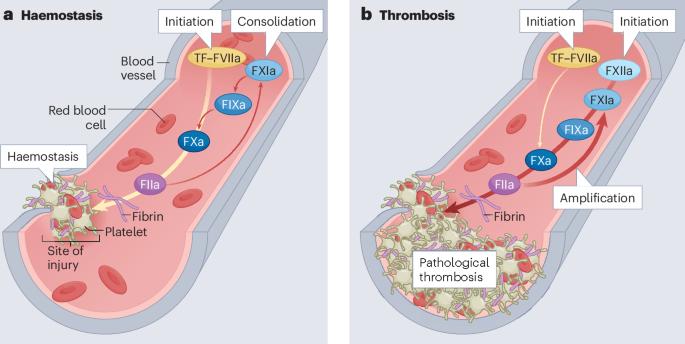Factor XI inhibitors for the prevention and treatment of venous and arterial thromboembolism
IF 44.2
1区 医学
Q1 CARDIAC & CARDIOVASCULAR SYSTEMS
引用次数: 0
Abstract
Therapeutic anticoagulation is essential to prevent and treat venous and arterial thromboembolism. The available agents target coagulation factors involved in thrombus formation but are associated with an increased risk of bleeding. Factor XI plays a minor role in haemostasis but contributes substantially to thrombus expansion, making it an attractive target to mitigate bleeding while maintaining antithrombotic efficacy. Various novel inhibitors, including antisense oligonucleotides, monoclonal antibodies and small molecules, have been developed. Phase II trials in orthopaedic surgery showed dose-dependent reductions in venous thromboembolism without significantly increasing bleeding compared with enoxaparin. In the first phase III trial of a small-molecule inhibitor of activated factor XI in patients with atrial fibrillation, asundexian was associated with a reduction in bleeding but also a higher risk of stroke, compared with apixaban. Factor XI inhibitors appear safe and hold promise for secondary prevention in myocardial infarction and ischaemic stroke, with ongoing phase III trials assessing their broader efficacy and safety. This Review discusses the rationale, pharmacology, evidence and future directions of factor XI inhibitors across various clinical settings. Inhibition of factor XI has emerged as a promising strategy to mitigate bleeding while potentially preserving antithrombotic efficacy. In this Review, the authors comprehensively discuss the rationale, pharmacology, evidence and future directions for factor XI inhibitors across various clinical settings.


因子XI抑制剂用于预防和治疗静脉和动脉血栓栓塞
治疗性抗凝对于预防和治疗静脉和动脉血栓栓塞是必不可少的。现有的药物靶向凝血因子参与血栓形成,但与出血风险增加有关。因子XI在止血中起次要作用,但在血栓扩张中起重要作用,使其成为在保持抗血栓疗效的同时减轻出血的有吸引力的靶点。各种新型抑制剂,包括反义寡核苷酸、单克隆抗体和小分子,已经被开发出来。骨科手术的II期试验显示,与依诺肝素相比,静脉血栓栓塞的剂量依赖性降低而不显着增加出血。在心房颤动患者小分子活化因子XI抑制剂的第一项III期试验中,与阿哌沙班相比,阿森地仙与出血减少相关,但也与卒中风险增加相关。因子XI抑制剂似乎是安全的,有望用于心肌梗死和缺血性卒中的二级预防,目前正在进行的III期试验评估其更广泛的有效性和安全性。本综述讨论了各种临床环境中因子XI抑制剂的原理、药理学、证据和未来方向。
本文章由计算机程序翻译,如有差异,请以英文原文为准。
求助全文
约1分钟内获得全文
求助全文
来源期刊

Nature Reviews Cardiology
医学-心血管系统
CiteScore
53.10
自引率
0.60%
发文量
143
审稿时长
6-12 weeks
期刊介绍:
Nature Reviews Cardiology aims to be the go-to source for reviews and commentaries in the scientific and clinical communities it serves. Focused on providing authoritative and accessible articles enriched with clear figures and tables, the journal strives to offer unparalleled service to authors, referees, and readers, maximizing the usefulness and impact of each publication. It covers a broad range of content types, including Research Highlights, Comments, News & Views, Reviews, Consensus Statements, and Perspectives, catering to practising cardiologists and cardiovascular research scientists. Authored by renowned clinicians, academics, and researchers, the content targets readers in the biological and medical sciences, ensuring accessibility across various disciplines. In-depth Reviews offer up-to-date information, while Consensus Statements provide evidence-based recommendations. Perspectives and News & Views present topical discussions and opinions, and the Research Highlights section filters primary research from cardiovascular and general medical journals. As part of the Nature Reviews portfolio, Nature Reviews Cardiology maintains high standards and a wide reach.
 求助内容:
求助内容: 应助结果提醒方式:
应助结果提醒方式:


